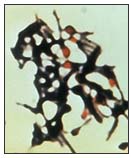Tetanus pathophysiology: Difference between revisions
No edit summary |
|||
| Line 10: | Line 10: | ||
Tetanus is an [[acute]], often [[fatal]], disease caused by an [[exotoxin]] produced by the bacterium Clostridium tetani. It is characterized by generalized [[rigidity]] and convulsive [[spasms]] of [[skeletal muscles]]. The muscle stiffness usually involves the [[jaw]] ([[lockjaw]]) and [[neck]] and then becomes generalized. C. tetani is a slender, [[gram-positive]], [[anaerobic]] rod that may develop a terminal [[spore]], giving it a drumstick appearance. The [[organism]] is sensitive to heat and cannot survive in the presence of [[oxygen]]. The spores, in contrast, are very resistant to heat and the usual [[antiseptics]]. They can survive [[autoclaving]] at 249.8°F (121°C) for 10–15 minutes. The spores are also relatively resistant to [[phenol]] and other [[chemical]] agents. The spores are widely distributed in soil and in the [[intestines]] and [[feces]] of horses, sheep, cattle, dogs, cats, rats, guinea pigs, and chickens. Manure-treated soil may contain large numbers of spores. In agricultural areas, a significant number of human adults may harbor the organism. The spores can also be found on [[skin]] surfaces and in contaminated [[heroin]]. C. tetani produces two exotoxins, [[tetanolysin]] and [[tetanospasmin]]. The function of tetanolysin is not known with certainty. Tetanospasmin is a [[neurotoxin]] and causes the clinical manifestations of tetanus. On the basis of weight, tetanospasmin is one of the most potent toxins known. The estimated minimum human [[lethal dose]] is 2.5 nanograms per kilogram of body weight (a nanogram is one billionth of a gram), or 175 nanograms for a 70-kg (154lb) human. | Tetanus is an [[acute]], often [[fatal]], disease caused by an [[exotoxin]] produced by the bacterium Clostridium tetani. It is characterized by generalized [[rigidity]] and convulsive [[spasms]] of [[skeletal muscles]]. The muscle stiffness usually involves the [[jaw]] ([[lockjaw]]) and [[neck]] and then becomes generalized. C. tetani is a slender, [[gram-positive]], [[anaerobic]] rod that may develop a terminal [[spore]], giving it a drumstick appearance. The [[organism]] is sensitive to heat and cannot survive in the presence of [[oxygen]]. The spores, in contrast, are very resistant to heat and the usual [[antiseptics]]. They can survive [[autoclaving]] at 249.8°F (121°C) for 10–15 minutes. The spores are also relatively resistant to [[phenol]] and other [[chemical]] agents. The spores are widely distributed in soil and in the [[intestines]] and [[feces]] of horses, sheep, cattle, dogs, cats, rats, guinea pigs, and chickens. Manure-treated soil may contain large numbers of spores. In agricultural areas, a significant number of human adults may harbor the organism. The spores can also be found on [[skin]] surfaces and in contaminated [[heroin]]. C. tetani produces two exotoxins, [[tetanolysin]] and [[tetanospasmin]]. The function of tetanolysin is not known with certainty. Tetanospasmin is a [[neurotoxin]] and causes the clinical manifestations of tetanus. On the basis of weight, tetanospasmin is one of the most potent toxins known. The estimated minimum human [[lethal dose]] is 2.5 nanograms per kilogram of body weight (a nanogram is one billionth of a gram), or 175 nanograms for a 70-kg (154lb) human. | ||
==Pathogenesis== | ==Pathogenesis== | ||
Revision as of 15:41, 23 February 2012
|
Tetanus Microchapters |
|
Diagnosis |
|---|
|
Treatment |
|
Case Studies |
|
Tetanus pathophysiology On the Web |
|
American Roentgen Ray Society Images of Tetanus pathophysiology |
|
Risk calculators and risk factors for Tetanus pathophysiology |
Editor-In-Chief: C. Michael Gibson, M.S., M.D. [1]
Overview
Pathophysiology & Etiology

Tetanus is an acute, often fatal, disease caused by an exotoxin produced by the bacterium Clostridium tetani. It is characterized by generalized rigidity and convulsive spasms of skeletal muscles. The muscle stiffness usually involves the jaw (lockjaw) and neck and then becomes generalized. C. tetani is a slender, gram-positive, anaerobic rod that may develop a terminal spore, giving it a drumstick appearance. The organism is sensitive to heat and cannot survive in the presence of oxygen. The spores, in contrast, are very resistant to heat and the usual antiseptics. They can survive autoclaving at 249.8°F (121°C) for 10–15 minutes. The spores are also relatively resistant to phenol and other chemical agents. The spores are widely distributed in soil and in the intestines and feces of horses, sheep, cattle, dogs, cats, rats, guinea pigs, and chickens. Manure-treated soil may contain large numbers of spores. In agricultural areas, a significant number of human adults may harbor the organism. The spores can also be found on skin surfaces and in contaminated heroin. C. tetani produces two exotoxins, tetanolysin and tetanospasmin. The function of tetanolysin is not known with certainty. Tetanospasmin is a neurotoxin and causes the clinical manifestations of tetanus. On the basis of weight, tetanospasmin is one of the most potent toxins known. The estimated minimum human lethal dose is 2.5 nanograms per kilogram of body weight (a nanogram is one billionth of a gram), or 175 nanograms for a 70-kg (154lb) human.
Pathogenesis
C. tetani usually enters the body through a wound. In the presence of anaerobic (low oxygen) conditions, the spores germinate. Toxins are produced and disseminated via blood and lymphatics. Toxins act at several sites within the central nervous system, including peripheral motor end plates, spinal cord, and brain, and in the sympathetic nervous system. The typical clinical manifestations of tetanus are caused when tetanus toxin interferes with release of neurotransmitters, blocking inhibitor impulses. This leads to unopposed muscle contraction and spasm. Seizures may occur, and the autonomic nervous system may also be affected.